Plurality of Americans Say US Should Be Neutral Mediator in Israel-Hamas War
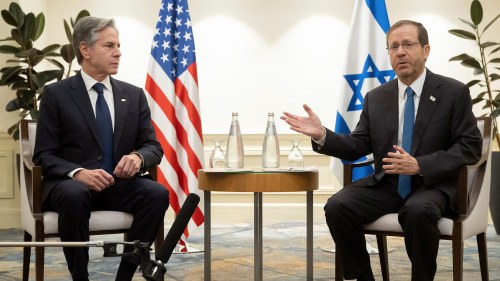
As the humanitarian toll in Gaza continues to climb and fears of a wider war grow, Americans are wary of direct military involvement in the conflict.
A roundup of polling on American attitudes toward the Israeli-Palestinian conflict, which re-escalated last month in the aftermath of an attack on Israel by Hamas, find that Americans remain more sympathetic to Israelis than Palestinians, but less so as Israel’s retaliation has intensified. In addition, the data show that Americans have become increasingly wary of direct military involvement in the conflict, as most would oppose sending US troops to Israel’s aid. Instead, the majority of Americans support sending military and humanitarian aid to Israel and Gaza, respectively, and using Washington's diplomatic relationship with Israel to de-escalate the situation.
Key Findings
- A plurality of Americans (39%) now say the United States should be a neutral mediator in the conflict, whereas previously a plurality of Americans (41%) said the United States should support Israel.
- More than half of Americans (57%) would oppose sending US troops to defend Israel if it were attacked by its neighbors, while 38 percent would support.
- Americans are now more supportive of sending US military aid to Israel than they were earlier in the conflict (from 51% in October to 54% in November).
- Two-thirds of likely voters (66%) agree that the United States should call for a ceasefire and de-escalation of violence in Gaza, and 71 percent of registered voters support the United States providing humanitarian assistance to help Palestinian civilians in Gaza.
- A plurality of Americans (41%) are more sympathetic to Israelis than to Palestinians, but less so than they were in the week immediately following Hamas’ attack on Israel (48%).
Introduction
Ahead of the Thanksgiving holiday, the White House brokered a deal between Israel and Hamas that saw the exchange of hostages for a multi-day humanitarian pause. While the Biden administration has remained steadfast in its unequivocal support for Israel’s response to Hamas, UN special rapporteurs and other world leaders have warned that the ongoing siege and assault has placed Gazans in grave humanitarian danger. In retaliation for Hamas’ attack on October 7, the Israeli government launched an ongoing military assault on the Gaza Strip that has, at this point, killed more than 14,000 Palestinians, injured almost 36,000, and trapped more than 6,000 under the rubble of demolished buildings.
In the immediate aftermath of the October 7 attack, polls showed that most Americans sympathized and sided with Israelis more than Palestinians. At the time, a majority of Americans also thought the response by the Israeli government was fully or partially justified given the brutal and surprising nature of Hamas’ attack. Now, more than eight weeks into Israel’s military assault on Gaza, the Palestinian death toll has reached a staggering height; graphic images of dead or injured civilians in the enclave have been circulating online; the conflict has spilled into the wider region; and both hostages taken by Hamas and Palestinian political prisoners remain held in captivity. As a result, Americans have become less sympathetic to Israelis than they were at the outset of the violence and are increasingly taking a neutral position on the conflict. While the majority of Americans think the United States should call for a ceasefire and support sending humanitarian aid to help civilians in Gaza, and a plurality prefer the United States be a neutral mediator in the conflict, Americans have also grown more supportive of sending military aid to Israel.
American Sympathies toward Israelis are Declining but Still Considerable
In the eight weeks since the Israeli-Palestinian conflict re-escalated, polls have shown that Americans remain more sympathetic to Israelis than to Palestinians but less so as the Israeli assault on Gaza has intensified.
Polling conducted by the Economist/YouGov over the last several weeks has tracked this shift in opinion. The share of Americans more sympathetic to Israelis rose to 48 percent by October 14, up from 42 percent the week prior. However, by the end of month, American sympathies for Israelis dropped to 37 percent, perhaps due to widespread media coverage of an airstrike on the Al Ahli Arab Hospital that killed more than 500 Palestinians, as well as other strikes on hospitals, residential buildings, and schools across the enclave. The latest Economist/YouGov wave of polling conducted November 2–7 shows a return to the levels of sympathy for Israelis similar to those recorded in the immediate aftermath of the October 7 assault (41%).
By contrast, nine percent of Americans were more sympathetic to Palestinians at the outset of the conflict’s escalation on October 7. American sympathies toward Palestinians have increased slightly since then and are now at a similar level to that recorded before Hamas’ attack (12%). A quarter of Americans say they sympathize with both sides equally, down from 28 percent in the October 21 wave and broadly consistent with previous readings.
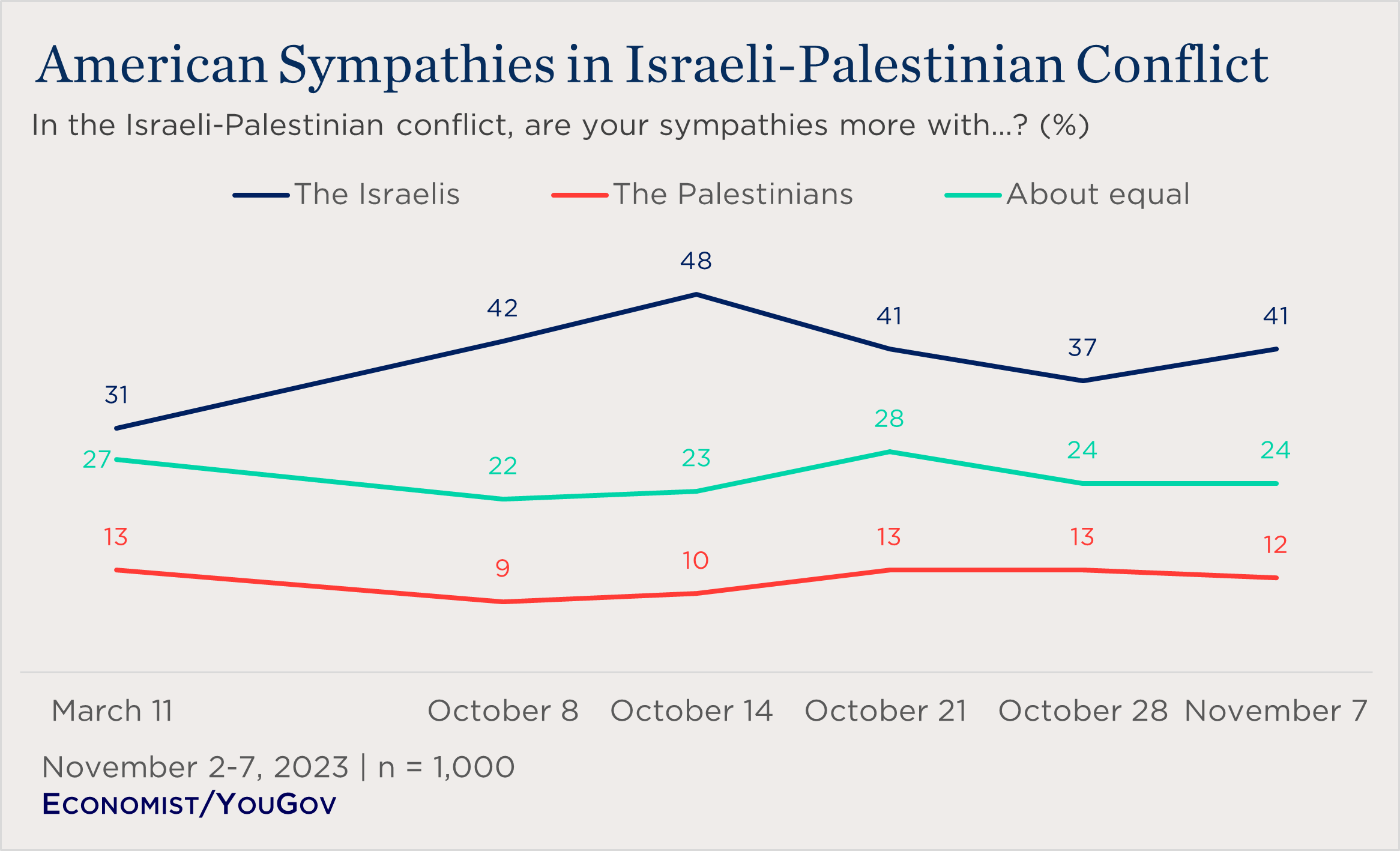
Democrats and Young Americans Driving Attitudinal Shifts Toward the Conflict
Findings from recent waves of the University of Maryland (UMD) Critical Issues Poll, conducted on October 20–22 and then again on November 3–5, show notable differences in attitudes toward the Israeli-Palestinian conflict between Democrats and young Americans on the one hand, and Republicans and older Americans on the other (as do other polls). The aforementioned shifts in sympathies from the Israeli side in the conflict are likely being driven by these divides across partisan affiliations and generations.
Among the overall public, the percentage of Americans wanting the United States to take Israel’s side in the conflict has dropped (from 43% in October to 37% in November), while the percentage of those wanting the United States to take neither side has increased since initial readings in late October (from 48% to 54% in November). A small percentage continue to say the United States should take the Palestinians’ side in the conflict (from 6% in October to 8% in November).
Democrats and to a lesser extent Independents think the United States should not take either side in the conflict, while a majority of Republicans say the United States should take Israel’s side. Even so, the data show that support for taking Israel’s side in the conflict declined among all three partisan groups in November. The share of Democrats preferring the United States take Israel’s side dropped by 10 percentage points (from 31% in October to 21% in November); the share of Republicans fell from 72 percent to 64 percent; and Independents’ support declined as well (from 38% to 34%). The data also showed a corresponding increase in support for taking neither side in the conflict and a slightly smaller increase in support for taking the Palestinians’ side among Democrats and Independents.
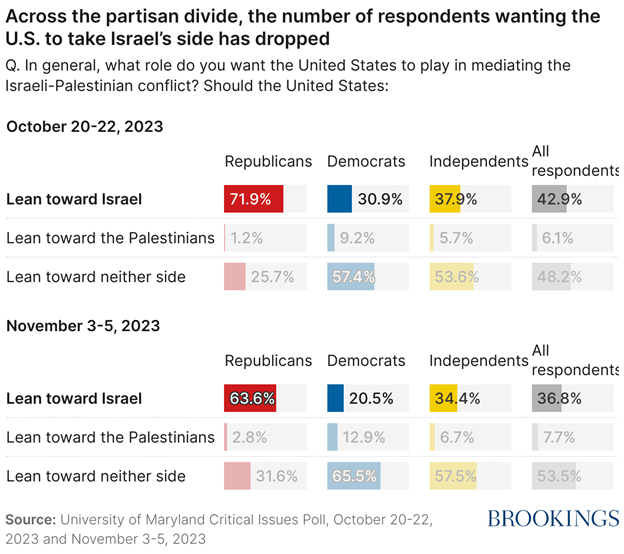
Across the United States, college campuses and major cities have become hotbeds for protests related to the conflict and the Biden administration’s response to it. Like the general public, young Americans (those under the age of 35) are now less likely to say the United States should lean toward Israel’s side (declining from 31% in October to 25% in November) and more likely to say the United States should take the Palestinians’ (rising from 12% to 16%).
The attitudes of young Republicans, in particular, have shifted more than those of other partisan affiliations. In October, nearly two-thirds of Republicans under 35 were likely to side with Israel (63%), but in November only about half of young Republicans (49%) said the United States should take Israel’s side in the conflict. Young Republicans have now grown more supportive of the United States taking neither side (from 30% in October to 42% in November). Comparatively, the attitudes of young Democrats and Independents have shifted to lesser degrees, with slight increases in favor of taking the Palestinian side.
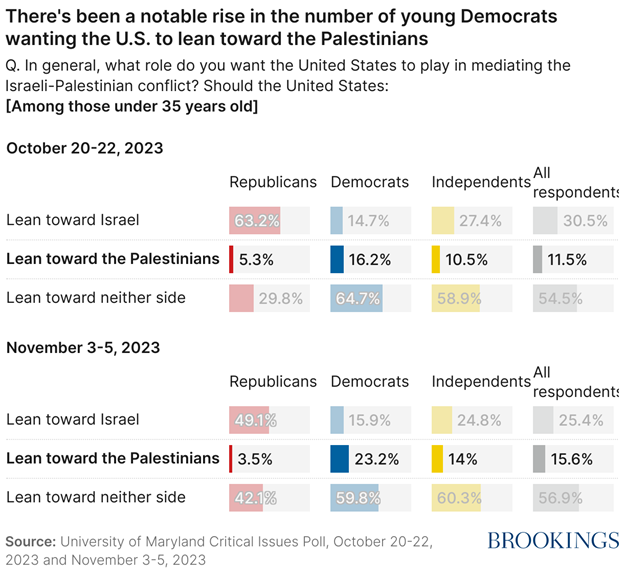
Americans Call for Ceasefire as Fears of Wider War Grow
According to an October 18–19 poll of likely voters by Data for Progress, the majority of likely US voters across the partisan spectrum strongly or somewhat agree (66%) that the United States “should call for a ceasefire and a de-escalation of violence in Gaza […] and leverage its close diplomatic relationship with Israel to prevent further violence and civilian deaths.” Democrats are the most likely (80%) to agree with the statement, followed by majorities of Independents (57%) and Republicans (56%).

A Quinnipiac University poll, conducted October 26–30, also found that seven in 10 registered American voters (71%) supported the United States providing humanitarian assistance to help Palestinian civilians in Gaza.
At the same time, a strong majority of voters (84%) were either very (43%) or somewhat (41%) concerned that the United States would be drawn into a military conflict in the Middle East, and a slim majority (51%) supported sending more military aid to Israel. Republican voters were most concerned about the possibility of the United States getting pulled into the conflict (52% were very concerned) and were most supportive of sending more military aid to Israel (65%). While 47 percent of Independents were also very concerned about the United States getting drawn in, they were divided on whether to send more military aid to Israel (46% supported vs. 47% opposed). Democrats were the least likely to say they were very concerned about the United States getting drawn in (30%), but a plurality supported (49% supported) sending more military aid to Israel (43% opposed).

Although calls for a ceasefire and de-escalation in Gaza have mounted, a more recent wave of the Quinnipiac University poll, conducted November 9–13, finds increasing support for sending US military aid to Israel among American voters. The share of voters that support sending more military aid to Israel has increased by three percentage points (from 51% in October to 54% in November) and is likely being driven by the attitudes among Republican voters and older Americans.
Seventy-one percent of Republican voters support sending military aid to Israel (up from 65% in October), while Democrats have grown less supportive (from 49% to 45%) and Independents have remained roughly divided (46% supported aid in October, 47% in November). This poll also finds the least support for sending military aid to Israel among voters between the ages of 18–34 (31% support vs. 65% oppose) and the most support among voters over the age of 65 (65% support vs. 25% oppose), reflecting deep divisions in attitudes across generations of American voters.
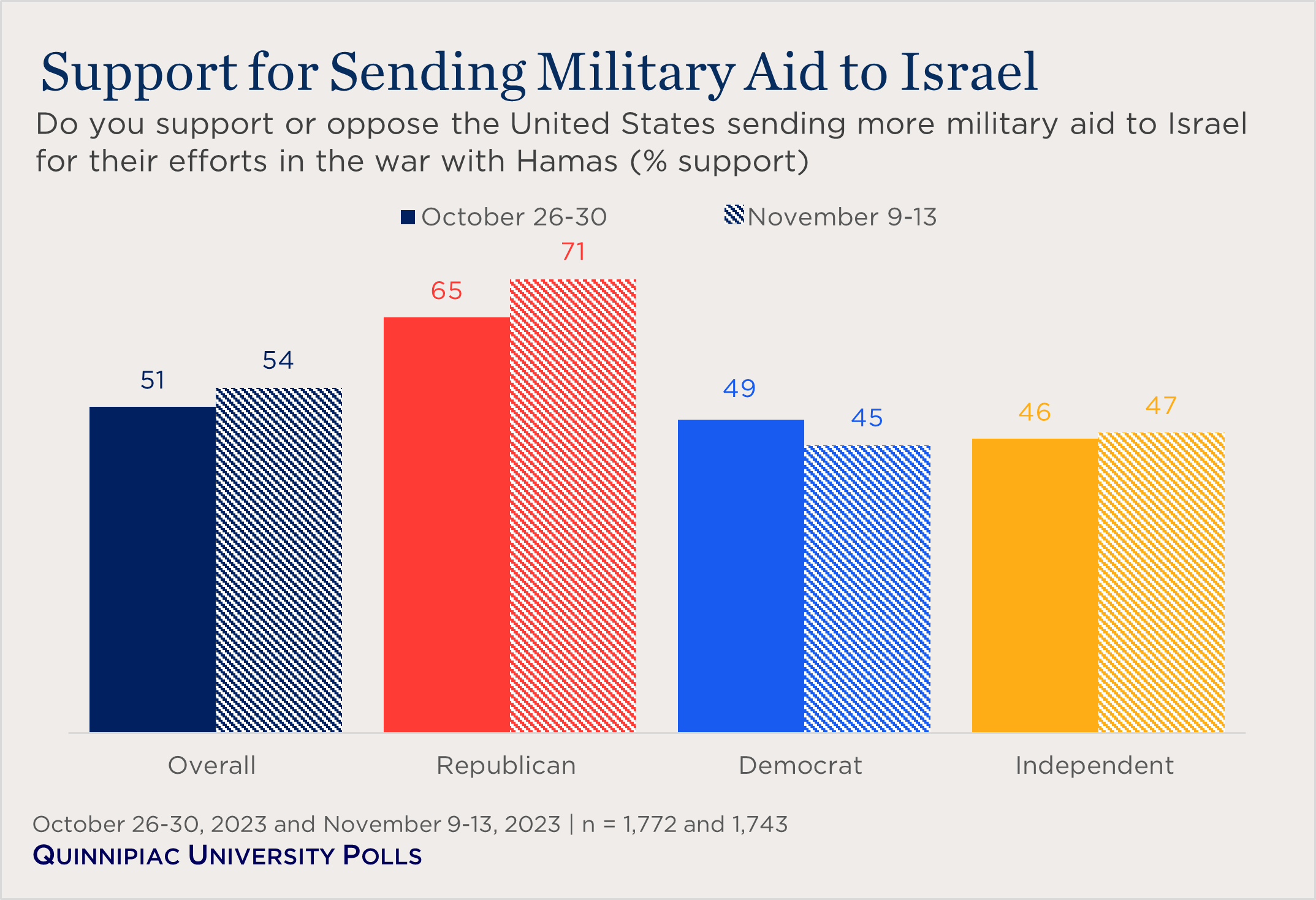
Americans Wary of Deepening Involvement in the Conflict and Prefer Mediatory Role
Polling by the Wall Street Journal and Ipsos, conducted on October 20, found that the majority of Americans (60%) would back the use of US troops as part of an international force to keep the peace between Israel and Palestinians. However, a majority of Americans said they would oppose sending US troops to defend Israel if it were attacked by its neighbors (57% oppose vs. 38% support). This measure is substantially lower than the levels that have supported committing US troops to defend Israel if it is attacked by its neighbors in similar polling by the Chicago Council on Global Affairs (about half consistently supported between 2010 and 2021). The WSJ/Ipsos poll further shows that Americans are more divided on whether to send US troops if Iran were to directly join the fight against Israel (50% oppose, 45% support).
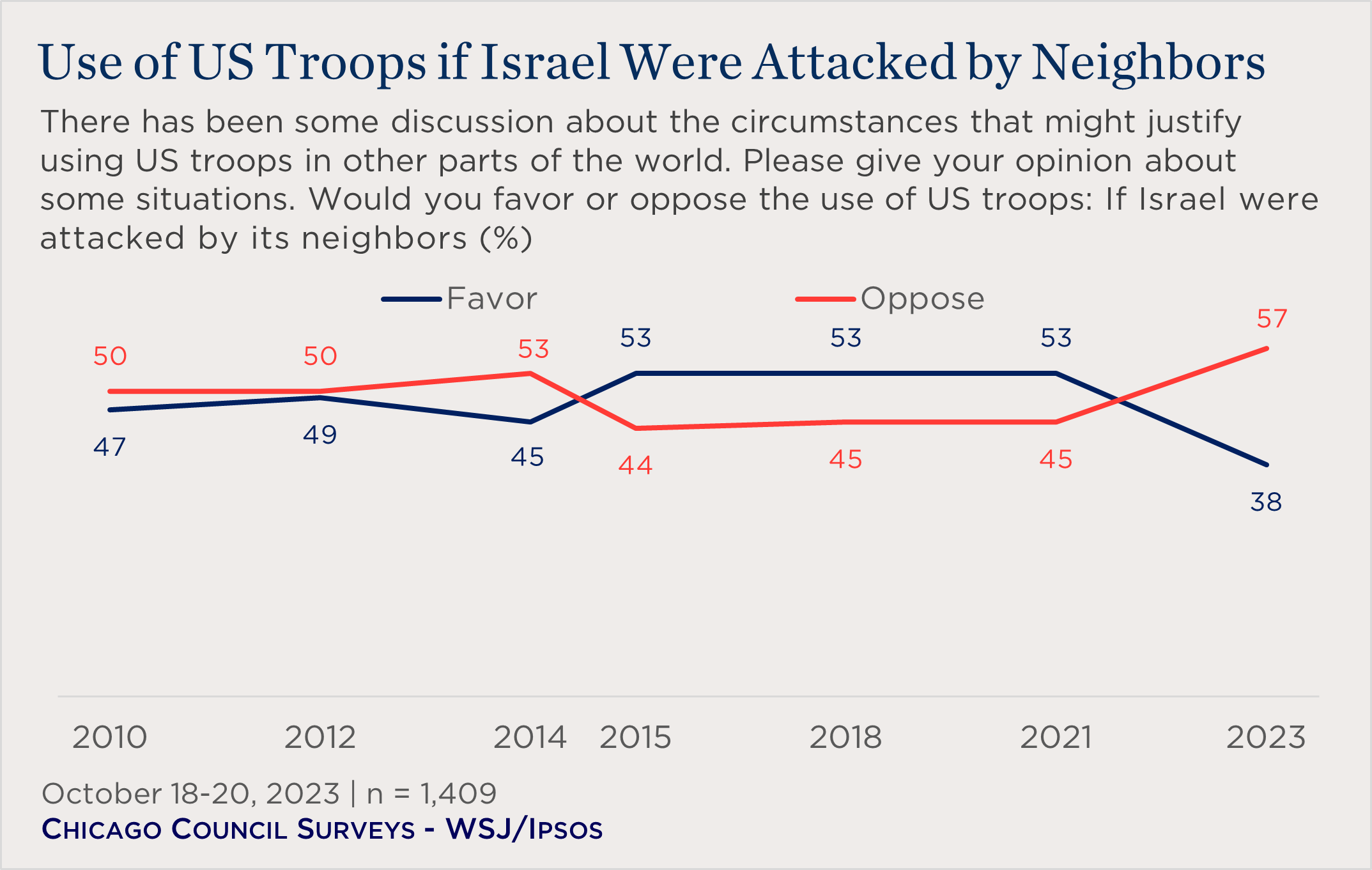
These findings suggest that Americans would prefer the United States play more of a peacekeeping and mediating role in the conflict rather than join it directly as a combatant. When asked about what involvement the United States should have in the conflict in a more recent Reuters/Ipsos poll, conducted November 13–14, a plurality (39%) said the US should be a neutral mediator. By contrast, when asked in October, a plurality (41%) of Americans said the United States should support Israel.
Conclusion
Although Israel and Hamas have agreed to temporarily pause their fighting to exchange prisoners, the totality of the humanitarian crisis caused by Israel’s month-long, unrelenting assault is staggering, and many in the international community have called for a more permanent ceasefire. Once highly sympathetic to Israelis and strongly supportive of the Israeli government’s response to Hamas, some Americans are now growing less convinced that the United States should take a side. Notably, Democrats and younger Republicans are fueling the shift away from Israel and toward a more neutral stance on the matter. Young Democrats have grown more sympathetic to Palestinians than Israelis, though the majority say the United States should take neither side in its mediatory role. As a whole, most of the American public agrees that Washington should make efforts to mediate and de-escalate the conflict to avoid a wider regional war.




Related Content
 Public Opinion
Public Opinion
Poll finds a majority of Americans value the US security partnership with Israel but say the status quo between Israel and Palestinians is unacceptable.
 Global Politics
Global Politics
Overall, Americans say the status quo between Israelis and Palestinians is unacceptable.
 US Foreign Policy
US Foreign Policy
But public opinion has likely shifted following Hamas' attacks on Israel.
